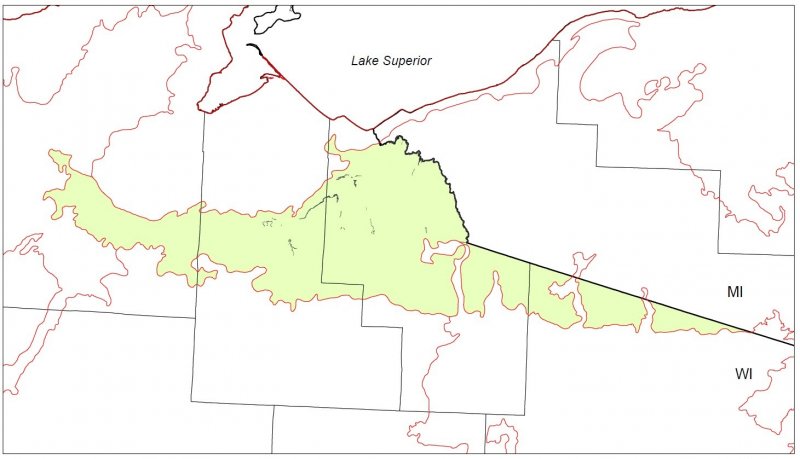
Natural Resources
Conservation Service
Ecological site F093BY003MI
Floodplains
Last updated: 9/27/2023
Accessed: 12/21/2025
General information
Provisional. A provisional ecological site description has undergone quality control and quality assurance review. It contains a working state and transition model and enough information to identify the ecological site.
MLRA notes
Major Land Resource Area (MLRA): 093B–Superior Stony and Rocky Loamy Plains and Hills
MLRA Notes:
The Wisconsin portion of this MLRA is a mixture of high-relief moraines and flat till plains with interspersed glacial meltwater deposits. It is bordered on the north by glaciolacustrine deposits of Glacial Lake Duluth and on the south by extensive pitted and unpitted outwash plains. The approximate land area is just under 600,000 acres (935 sq miles).
The Penokee-Gogebic Iron Range runs through the middle of the Wisconsin portion of this MLRA and into Michigian. The range is a hilly, bedrock-controlled moraine. The bedrock outcropping is composed of igneous and metamorphic materials and was created by inland folding and faulting of the ancient Superior continent when it collided with the Marshfield continent about 1.8 billion years ago (Dott & Attig, 2004). Volcanic and intrusive bedrock occurs in some places. This bedrock is overlain by a thin layer of glacial till deposited by the Chippewa Lobe.
To the north of the range is a former spillway for Glacial Lake Ontonagon. The flowing meltwater cut deep channels into the morainal systems. Glaciofluvial landforms here include old beaches and dunes. South of the range, along the southern edge of this MLRA, are rolling collapsed end moraines, pushed to their extent by the Chippewa and Ontonagon Lobes. The landscape is dotted with abundant kettle lakes and swamps, especially in the eastern portion. Ice-walled lake plains and eskers are also found along these collapsed moraines.
The climate is influenced by Lake Superior in areas near the lake, resulting in cooler summers, warmer winters, and greater precipitation – especially snowfall – compared to more inland locations. Historically, mixtures of eastern hemlock (Tsuga canadensis), sugar maple (Acer saccharum), yellow birch (Betula alleghaniensis), eastern white pine (Pinus strobus), and red pine (Pinus resinosa) covered the area. In wetter pockets (such as the swamps that dot the moraines to the south) white cedar (Thuja occidentalis), black spruce (Picea mariana), and tamarack (Larix laricina) were common (Finley, R., 1976).
Classification relationships
Relationship to Established Frameworks and Classification Systems:
Habitat Types of N. Wisconsin (Kotar, 2002): Two sites key out to Acer saccharum – Tsuga canadensis/ Athyrium felix-femina – Onoclea sensibilis (ATAtOn), one site keys to Acer saccharum – Tsuga canadensis/ Maianthemum canadense (ATM), and one site keys to Acer saccharum/ Hydrophyllum virginianum (AH).
Biophysical Setting (Landfire, 2014): This ES is mapped as Boreal Acidic Peatland System, Laurentian-Acadian Northern Hardwoods Forest – Hemlock, and Eastern Boreal Floodplain; though, it is best represented by the latter.
WDNR Natural Communities (WDNR (2015): This ES is most similar to the Floodplain Forest.
Hierarchical Framework Relationships:
Major Land Resource Area (MLRA): Superior Stoney and Rocky Loamy Plains and Hills, Eastern Part (93B)
USFS Subregions: Winegar Moraines (212Jc)
Small sections occur in the Gogebic-Penokee Iron Range (212Jb) subregion
Wisconsin DNR Ecological Landscapes: North Central Forest
Ecological site concept
The Floodplains ecological site is uncommon in MLRA 93B, located in floodplains, primarily (but not exclusively) along Tyler Forks, Devils Creek, and the Montreal and Potato rivers. These sites are characterized by very deep, poorly to moderately well drained soils that formed in loamy alluvium. Sites are subject to occasional ponding and flooding. Water is received primarily from stream inflow, precipitation, runoff from adjacent uplands, and groundwater inflow. Sites may remain saturated for long durations and meet hydric soil requirements. Soils range from strongly acid to slightly acid.
Floodplains sites are defined by their landform (i.e. situated on a floodplain). The vegetation must be tolerant of flooding from stream inflow.
Associated sites
| F093BY005MI |
Moist Lowlands Many ecological sites are found adjacent to Floodplain sites. Any upland sites adjacent to a river can be associated with this ecological site. |
|---|
Similar sites
| F093BY002MI |
Mucky Swamps Mucky swamps consist of deep, highly decomposed herbaceous organic material. These soils remain saturated throughout the year and some sites are subject to occasional ponding and flooding. They are neutral to moderately acidic. These are wetland sites that may sometimes occur on floodplain landforms, but they are distinguished from Floodplains by their drainage class (very poorly drained). |
|---|
Table 1. Dominant plant species
| Tree |
(1) Acer saccharum |
|---|---|
| Shrub |
Not specified |
| Herbaceous |
(1) Matteuccia struthiopteris |
Click on box and path labels to scroll to the respective text.
Ecosystem states
State 1 submodel, plant communities
| 1.1.B | - | Major flooding; sedimentation |
|---|---|---|
| 1.2.B | - | Decrease in ponding |
